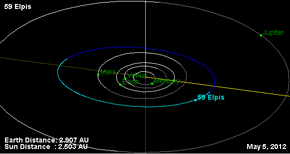 Orbital diagram | |
| Discovery | |
|---|---|
| Discovered by | Jean Chacornac |
| Discovery date | September 12, 1860 |
| Designations | |
| (59) Elpis | |
| Pronunciation | /ˈɛlpɪs/[1] |
Named after | Elpis |
| Main belt | |
| Adjectives | Elpidian /ɛlˈpɪdiən/[2] |
| Orbital characteristics | |
| Epoch December 31, 2006 (JD 2454100.5) | |
| Aphelion | 453.624 Gm (3.032 AU) |
| Perihelion | 358.808 Gm (2.398 AU) |
| 406.216 Gm (2.715 AU) | |
| Eccentricity | 0.117 |
| 1634.355 d (4.47 a) | |
| 246.848° | |
| Inclination | 8.631° |
| 170.209° | |
| 210.901° | |
| Physical characteristics | |
| Dimensions | 164.8±6.0 km[3] |
| Mass | (3.00±0.50)×1018 kg[4] |
Mean density | 1.30±0.26 g/cm3[4] |
| 13.69 h[3] | |
| 0.044[3][5] | |
| CP/B[3] | |
| 7.93[3] | |
59 Elpis is a large main belt asteroid that orbits the Sun with a period of 4.47 years. It is a C-type asteroid, meaning that it is very dark and carbonaceous in composition. In the Tholen scheme it has a classification of CP, while Bus and Binzen class it as type B.[6]
Elpis was discovered by Jean Chacornac from Paris, on September 12, 1860. It was Chacornac's sixth and final asteroid discovery.
A controversy arose over the naming of Elpis. Urbain Le Verrier, director of the Paris Observatory, at first refused to allow Chacornac to name the object, because Leverrier was promoting a plan to reorganize asteroid nomenclature by naming them after their discoverers, rather than mythological figures. A protest arose among astronomers. At the Vienna Observatory, Edmund Weiss, who had been studying the asteroid, asked the observatory's director, Karl L. Littrow, to name it. Littrow chose Elpis, a Greek personification of hope, in reference to the favorable political conditions in Europe at the time. In 1862, Leverrier permitted Chacornac to choose a name, and he selected "Olympia" at the suggestion of John Russell Hind.[7] However, Elpis is the name that stuck.[8]
Elpis has been studied by radar.[9]
- ^ The Century Dictionary and Cyclopedia, under "Schwartz, Madame von"
- ^ E.g.American ecclesiastical review, v. 21 (1899)
- ^ a b c d e "JPL Small-Body Database Browser: 59 Elpis" (2011-09-01 last obs). Jet Propulsion Laboratory. Retrieved 26 January 2012.
- ^ a b Cite error: The named reference
Carry2012was invoked but never defined (see the help page). - ^ Asteroid Data Sets Archived 2009-12-17 at the Wayback Machine
- ^ Cite error: The named reference
Rivkin2003was invoked but never defined (see the help page). - ^ Appletons' annual cyclopaedia and register of important events of the year: 1862. New York: D. Appleton & Company. 1863. p. 173.
- ^ Schmadel, Lutz D. (2003). Dictionary of Minor Planet Names. Springer Science & Business Media. pp. 20–1. ISBN 978-3-540-00238-3.
- ^ "Radar-Detected Asteroids and Comets". NASA/JPL Asteroid Radar Research. Retrieved 26 January 2012.